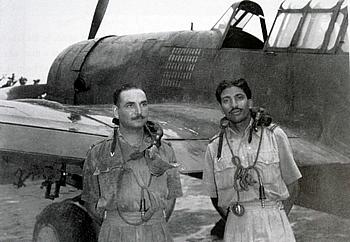In this article, the author, Col N N Bhatia tells the family background and story of Gp Capt Karori Lal Bhatia, who led No.12 Squadron during the 1947-48 War, and was the first pilot to land at Srinagar in Kashmir during the airlift of troops into Srinagar.
In this article, the author, Col Bhatia tells the family background and story of Gp Capt Karori Lal Bhatia, who led No.12 Squadron during the 1947-48 War.
| Group Captain Karori Lal Bhatia, seen in this photograph taken just after 1947. | 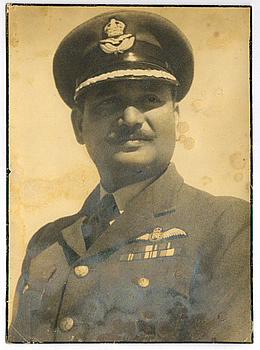 |
The Bhatia Clan and Karori’s Younger days.
According to “The Annals and Antiquities of Rajputana” (1890- Volumes I & II) by Lt Col James Todd, the ancestors of the “Bhattiah” or “Bhatia” were one of the equestrian orders of the Bhatti or Bhati ruling Rajput clan from the erstwhile princely state of Jaisalmer in Rajputana, who to ward off atrocities of the Muslim warlords, migrated towards North, Western Indian Peninsula and Sindh, diversifying their profession to commerce that brought them immense wealth and prosperity.
Our family ancestors had migrated to Sargodha -Sialkot belt where due to their sheer hard work; they became progressive, prosperous land cultivators, professionals and businessmen. Bhatia’s by and large were enlightened and educated, having a progressive attitude, especially in giving equal opportunities to both male and female children in acquiring education. My maternal grandmother, Bharavan Wali were two sisters. The other sister was named Veeran Wali. Their names literally meant ‘one having many brothers’. Their parents in desperation to have a male child had named them as such, but alas they did not have a brother! Bharavan Wali at the age of 13 was married to educated English-speaking young man called Kanshi Ram.
My maternal grandfather who belonged to Bhera (Sargodha) was a liberal educated Sanskrit scholar and young Station Master in British Indian Railways in Haripur Hazara where my mother was born on 5 Sep 1916. My mother was the eldest of 6 siblings-four sisters and two brothers. It was at Karor, a small Railway Station in the tribal area where my grandfather was posted that their first male child was born on 29 January 1920, leading to big family celebrations. Appropriately the child born in Karor was named as ‘Karori Lal’ or ‘the gem of Karor’.
Karori Lal grew up to be a tall, fair and handsome young man with a cherubic face, golden hair and an infectious smile. He was quiet, serious with a humorous side too. He excelled both in studies and sports and represented his college in the Punjab State wrestling team. My parents were married on 18 May 1931 and within 21 days of their marriage, my maternal grandfather suddenly passed away after a brief illness leaving the entire family shattered with no source of income and all family responsibilities fell on the young shoulders of 11 years old Karori Lal. It goes to the credit of my grandmother, who though uneducated, as a young widow with 6 children brought the family well. Kirori Lal did his BA from DAV College Lahore.
 |
Karori Lal seen in civvies before his commissioning |
Hawai Sepoy
In order to support his family, Karori Lal gave tuitions in his free time. After graduating from college, it was imperative that he finds employment as soon as possible to support his family since family had no references for a recommendation to get a commission in the Indian Air Force as an officer, he joined the Indian Air Force as a Hawai Sepoy (Airman).
On a cold and grey stormy evening at the Peshawar Air Force Base, while not a soul was present at the airfield, Squadron Leader Subroto Mukherjee (later Air Marshal, and the country’s first Indian Air Chief), worried about the safety of aircraft and their maintenance for the next day’s operational sorties thought of taking round of the parked aircraft. To his amazement nay shock, he saw a lone Hawai Sepoy (Airman) working on maintaining the aircraft. He gripped airman’s arm and to his horror found the young technician having very high fever. He asked this young airman why in such an inhospitable weather was he was maintaining the aircraft. The young man replied that the aircraft safety, maintenance and munitions loading were far more important than his fever. So impressed was Subroto Mukerjee, that in the following weeks, he strongly recommended the airman for ‘Y’ Cadets course, a prerequisite for commission in the Force as an officer from the ranks.
Karori Lal got his commission on 1st August 1940 as Pilot Officer GD(P) in the Indian Air Force Volunteer Reserve (IAFVR). He was sent to Risalpur for initial flying training as part of the 4th Pilots Course (PC) with the Flying Training School’s Initial Training Squadron. Flying training at ITS was completed at the end of Nov. 1940 and the batch of officers moved to Flying Training School, Ambala for advance training, which got over on 25th May 1941
Flying Blenheims and Hudsons.
While most of his batch of pilots were sent to No.1 or 2 Squadrons, Bhatia and a few were sent to the various IAFVR Flights engaged in Coastal Defence. Karori Lal’s posting was for No.3 (Calcutta) Flight, IAFVR which was engaged in flying Coastal patrols operating from Dum Dum airport. No.3 Flight was under and later was commanded by Flt Lt Hem Chadhuri.
In early Dec 41, No.3 Flight had the distinction of equipping with four Bristol Blenheim twin-engine bombers. All the Indian pilots of No.3 Flight became the first IAF pilots to fly multi-engine aircraft on operational sorties. The Flight engaged in operations in Burma in January 42 operating from Bassein. The flight operated two Blenheims from Bassein over the Gulf of Martaban, escorting troopships and supply vessels into Rangoon. The other two Blenheims operated from Zayatkwin. The flight withdrew to Dum Dum in early March 42.
On return from Burma, No.3 Flight re-equipped with Lockheed Hudsons. In June 42, the flight was absorbed into No.353 Squadron RAF as the Indian Flight. All the pilots, including Hem Chadhuri, K L Bhatia went to the RAF Squadron. In November 42, Air HQ (India) sent a directive disbanding all the IAFVR Flights and amalgamating the personnel into newly raised Squadrons. All Indian Personnel from No.104 GR Squadron and the Indian Flight of No.353 Squadron RAF were to form the newly raised No.7 Squadron, IAF at Visakhapatnam. By this time Karori Lal had accumulated over 105 hours on multi-engined types – including the Blenheim, Atlanta and the Hudson.
 |
A photograph from 1942 showing Indian personnel of No.3 Flight, IAFVR with one of their Blenheims. The CO, Flt Lt Hem Chadhuri is standing 2nd from left. The person standing first from left is believed to be Fg Offr K L Bhatia. Standing first from right is possibly Fg Offr V Srihari, who would move to No.7 Squadron along with the others. Several other photographs of the personnel of No.3 CDF appears in the Eagle Strikes. |
No.7 Squadron – Waziristan Operations.
No 7 Squadron was formed on 01st December 1942 at Vishakapatnam under the command of Sqn Ldr Hem Chaudhuri. After W/T course at Bombay and Operational Training at 152 OTU in Peshawar, the unit acquired its first aircraft on 20 April 1943 in Allahabad, about the same time that Karori Lal started his flying with No.7 Squadron. By mid 1943, flying training and gunnery training was accomplished at Kohat.
The first taste of action was over Northern Waziristan on 3 Dec 43, when Fg Offr KL Bhatia and Flt Lt PC Lal (Later Air Chief Marshal PC Lal, DFC) dive-bombed targets at Tsepal Phasi near the Tochi River. Fg Offr Bhatia along with his Navigator, Fg Offr Victor Srihari in Vengeance AN672 led the mission at 1530 Hours. Prior to the sortie, both the pilots, Bhatia and Lal flew over the target in an Audax aircraft. After returning, they took off from Miranshah in their Vultee Vengeances. The British political agent flew in a Harvard as an observer. Fg Offr Bhatia is reported to have got a direct hit on the target. This was the first taste of ‘Operation’ for No.7 Squadron.
A second operational mission happened on 21st Dec 43, when a four aircraft mission from No.7 Squadron bombed the same target, with Fg Offr Bhatia again having the honour of leading the mission. The Squadron CO, Sqn Ldr Hem Chaudhuri flew as No.4 in the formation.
Move to Burma
Pending transfer to the Burma front, the unit was earmarked to go to Gwalior for training with an Army formation for close support activities. Of the nine aircraft that flew in on 19 Feb 44, three crashed as they had run into poor visibility and dust storms. Two pilots and two gunners were killed, while Fg Offr Gokal and his Gunner Ghosh survived their forced landing. After training extensively with the Army, the Battleaxes (the name given to the officers and airmen of 7 Sqn.) were given orders to move to Kumbhirgham in Assam by 12 March 1944. The Squadron was deployed at Uderbund airstrip, about 12 km from Kumbhirgham.
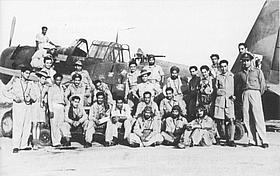 |
Flying Officer KL Bhatia sitting on the ground in the extreme right, Sqn. Ldr Hem Chaudhury (Sqn. Commander) is suiting in the centre & Flying Officer D C Seth standing behind Sqn. Ldr. Chaudhury is in the above picture). The aircraft is a Vultee Vengence, dive bomber. Photo Courtesy: Vayu Aerospace |
Flt Lt KL Bhatia flew umpteen missions as part of Battleaxes – the Chindwin, Myothit, Japanese Army encampments at Imphal, Army convoys on the Tiddim Road, Maungdaw, Razabil etc were just a few of them. There were remarkable victories and many fatal losses. In June 44, Battleaxes moved to Ranchi for training and conversion to the Hawker Hurricane and onward deployment to Peshawar.
Marriage
In Peshawar, his close friendship with Flt Lt DC Seth developed into lasting friendship & relationship. Flt Lt & Mrs. Seth were perfect hosts to young Indian officers who would often drop in for a meal and drinks. Mrs. Pran Seth, the eldest daughter of Lal Chand Khanna who was an aristocratic Zamindar of that area owning the whole village of Khanna in Peshawar. In Lal Chand Khanna’s 101-room Haveli, many of the service’s newlywed officers including Seths were staying due to paucity of accommodation in Peshawar Cantonment.
Karori Lal used to often visit Seths and met Padamanjali Khanna, the youngest daughter of the aristocratic Zamindar and the youngest sister of Mrs Pran Seth. Mr. Khanna was highly impressed by Karori Lal’s simplicity, handsome bearing and commitment towards both his family and profession that he readily agreed to marry his youngest daughter Padmanjali with him. However, his only condition was that the engagement and wedding would take place when the Second World War ends.
In March 45, No.7 Squadron was sent on its second tour of duty on the Burma Front where Karori Lal took part in many sorties during the tour. He was now one of the flight commanders of the Squadron. The Squadron carried out a fantastic 1033 hours of flying in a month that was unequalled by any other Squadron in the 221 Group. In recognition of its achievements, in March 1945 the Indian Air Force was bestowed with the prefix ‘Royal’ and thereafter was known as the Royal Indian Air Force.
On returning from their second tour, No.7 converted to Spitfire Mk VIIIs in November 45. In December 45, Karori Lal was given a Permanent Commission in the post-war RIAF.
Till then, Karori Lal was one of the oldest members of No.7 Squadron. He was serving with them right from the formation in 42. The tenure came to an end in Jan 46, when orders came for his posting to Air HQ(I) (Supply). The entire Squadron organised a special farewell for him.
In April 46 Karori Lal and Padmanjali were married in Peshawar. Needless to say, the convent-educated English speaking tomboyish Padmanjali quickly adjusted well both with husband’s humble but large and affectionate Bhatia family and the Indian Air Force. Young Bhatia’s were blessed with two sons-Aneesh, who retired as a Major from the 2 Lancers in the Indian Army and Ranjeet, who went to the Corporate Sector.
No 12 Squadron and No.6 Squadron
No. 12 Squadron was raised post-WW2 in Kohat on 1st December 1945. They initially operated the Spitfires under Sqn Ldr Haider, who opted for Pakistan following the partition of the country. The Spitfires were replaced with Oxfords in early 1946 and the Squadron was at that time designated as the first Transport Squadron of the Royal Indian Air Force. In February 1947, the squadron converted to the C-47 Dakotas.
Karori Lal Bhatia had been posted to No.12 Squadron in January 47 as the Flight Commander when the unit converted to Dakotas. Little surprise keeping in view his background on multi-engine types like the Blenheim and Hudson. In May 47, when the RIAF decided to convert one of its Squadron to a second Transport Squadron, Karori Lal was posted to the newly converted 6 Squadron as its Commanding Officer. Karori Lal’s stint as the CO did not last long due to the partition throes that the nation was going through. No.6 Squadron was allocated to Pakistan and all its personnel who opted for India, including Karori Lal were airlifted in August 47. Sqn Ldr Karori Lal Bhatia handed over command of the Squadron to an officer of the RPAF.
Meanwhile, after partition, No.12 Squadron stayed with the Indian Air Force. On 15th August 1947, Sqn Ldr Karori Lal Bhatia took over as the commanding officer of No.12 Squadron at Agra. Certainly, Bhatia’s experience flying Atlantas, Blenheims and Hudsons, and his previous stint as Flight Commander, have played a part in his selection to command the IAF’s only transport Squadron at that time.
1947-48 Kashmir Operations
The RIAF lost many permanent bases, squadrons and other establishments as a result of the division of the country. It had virtually no breathing space to recover from the surgery that had accompanied the partition before it was called to action in 1947-48 J&K Operations. The RIAF evacuated a large number of personnel from newly created Pakistan.
In October 47, Tribal raiders, clothed, fed and armed by Pakistan with Pakistani army officers leading them raided Kashmir. On 26 October the Maharaja of Kashmir signed the Instrument of Accession as per the requirements of the partition process and pleaded for Indian military help. The lone transport Squadron under the command of Wing Commander KL Bhatia was not to be left behind. He piloted the very first aircraft into the Kashmir Valley on 27 October 47, carrying troops of 1 Sikh under Lt Col D R Rai.
No.12 Sqn, in the course of its regular casualty evacuation and transport duties, airlifted 25 pounder field guns to Poonch and also ran bombing sorties with their trusted Dakotas in Poonch. They also flew the first Indian Army troops to Poonch and then Leh. Their aircraft were the first aircraft to land at Poonch and then Leh, and bombing sorties in support of the army with the bombs being rolled out of the cargo bay by the aircrew. The main driving force behind the squadron was Air Commodore Mehar Singh, head of the Operational Group in Jammu & Kashmir. He himself led many of the pioneering flights including the ones to Leh and Poonch. For leading and guiding the air operations in Jammu & Kashmir, he received the Maha Vir Chakra.
The Incident at Poonch 21st March 1948
The picture above is of the Dakota which got shelled by Pakistani artillery while it was being flown by Wg. Cdr K L Bhatia on Mar. 21st 1948. Wg. Cdr K L Bhatia was carrying ammunition to the besieged Indian Army garrison in Poonch. His aircraft was coming into land in Poonch when the enemy artillery on the hills opened fire on the aircraft. The aircraft received a direct hit as a result, the tail fin (Vertical stabilizer) was blown off, thereby destabilizing the aircraft on its critical landing approach. In spite of the odds against him, he managed to safely land the aircraft. This mission was one of its kind. The much-needed ammunition and supplies enabled the Indian army to defend Poonch from the enemy. The eventful page from the Log Book of Wg. Cdr KL Bhatia, is appended below:
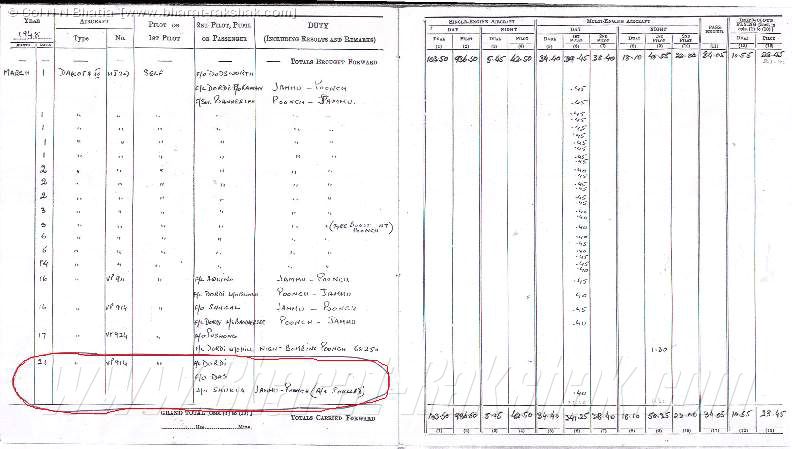 |
Hyderabad Action
In April 48, Karori Lal relinquished command of 12 Squadron and went to HQ , Training Group in Bangalore. It was during this time that the Hyderabad Police Action commenced. Wg Cdr Bhatia flew several sorties in the month of September. With many flights to airfields like Gannavaram, Tambaram, Hakimpet, Begumpet and Bidar.
Soon after the Hyderabad action, Karori Lal went to Agra as the Station Commander (then CO, 4 Wing). He was to remain as Station Commander till 1951, being promoted to Group Captain in Feb 1950.
The Kashmir Operations ended with Karori Lal being the Station Commander at Agra. During this time the fledgeling Indian Air Force committed almost its entire fighter resources to the 1947-48 Kashmir Operations. Tempests of Nos 7, 8 and 10 Squadron took part in the fighting as well as the sole Transport Squadron, No.12 flying the venerable Dakota. It was a matter of great pride for the Bhatia clan & the IAF when Gp Capt Bhatia, , informed the spectators that the Transport Squadron operating at Agra Air Force Station had won 13 out of 19 Vir Chakras awarded to the IAF for its heroic deeds in J&K Operations. The fighting ended on 31 December 1948, the cease-fire bought about by UN Mediation.
Karori Lal himself got the Vir Chakra along with many pilots of the squadron. The award was announced in January 1950 when India became a republic and the Gallantry Awards were instituted.
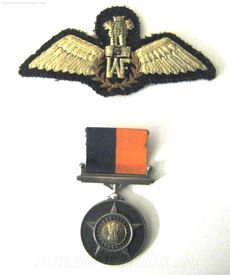 |
The Pilot Brevet and Vir Chakra Medal awarded to Group Captain Bhatia. Click Here to read the citation |
The Last Post
From Agra, Group Captain Bhatia was posted as Director Personnel at Air Headquarters in 1952- the post now held by an Air Marshal. He was extremely busy in restructuring the Service immediately after the partition and J&K War and often complaint of chest pain, breathlessness, fever & stress but nothing could be diagnosed. He would often be advised rest and short breaks that he spent in duck shooting in Okhla barrage and Bharatpur and his new passion farming near Bilaspur in the Terai region.
Though he was not very religious yet my maternal uncle was most God-fearing and did his prayers in very simple ways. Before any meal he would smilingly simply pray, ‘Rabba aieyo jaya khana sub nu de. Iss to wadiya dena hoi te sab to pehle mainu de – “God give this type of food to every one, but if You are giving it any better, give me that first.”
He had equally refined sense of humour. During their first flight to Leh, Wg Cdr Bhatia’s aircraft was very low on fuel and he radioed so to Air Cmde Mehar Singh who replied,’ apna jahaj mere jahaj utte le aa, meaning fly behind my aircraft.’ Wg Cdr Bhatia replied, ‘senior de utte chala ke marna hai Sir’. That shows the quality of the leadership under grave threat and stress of these two flying legends of all time.
Sometime in 1953, he started to complain of pain in the chest while doing high altitude sorties. On investigation he was declared suffering from lung cancer. He was flown to Tata’s Institute Bombay & from there to London for the treatment. He was operated twice but the disease spread fast damaging his entire respiratory system and other vital organs. Group Captain Bhatia sensing his end, desired to return home. A few days before his end, he got a commitment from his lifelong friends & close relatives Wg Cdr & Mrs. Seth that they would take care of his family in his everlasting absence. He breathed his last on 20 Jan 1954 at the age of 34 yrs leaving his family and the Indian Air Force shattered forever. It goes without saying, that the Seths looked after Mrs Bhatia & her two small sons for over two decades as part of their extended family and that must be a big solace to the soul of ‘Gem of karor’.
Karori Lal , from a humble background, from a Hawai Sepoy rose to Group Captain in just a span of 10 years during which more than 8 years he spent in combat in Waziristan, Burma, J & K & the Hyderabad action. His flying encompassed over 2842 hours. In between, he got married, was blessed with two sons, graduated from the Staff College Quetta and was decorated with Vir Chakra for his role in the Poonch Operations.
It was a matter of great courage and fortitude for the young widow of 28, Mrs Bhatia, who not only brought up her both the sons well but like her brave and dedicated husband, served the young widows of the Indian Air Force for over two decades in their rehabilitation as the Hony. Secretary of the Air Force Benevolent Association.
My Memories
With the award of Vir Chakra, the Government honoured Gp Capt Bhatia by gifting 150 acres of agricultural land near Bilaspur along with his war contemporaries like Air Commodore Mehar Singh, Maha Vir Chakra. During his short leaves and breaks from pressing work demands, he would drive down in his black Austin to his ‘Bhatia Farm’ to develop it as a model agro outlet. I as a small boy, recollect him passionately with a missionary zeal ploughing tractor every night during his holidays to develop the farm. He rehabilitated his younger brother Krishan on the farm on an equal partnership basis. He also became the guiding force in helping all our family members in rehabilitation after the horrors of the partition.
My own elder brother Prem Nath Bhatia was groomed by him to join Joint Services Wing (JSW) but alas he died a few months before Prem was commissioned in 6 KUMAON. Prem followed his footsteps in letter and spirits, winning like him, Vir Chakra in 1962 Sino- Indian War and breathing his last on 28 Feb 1965 on the last day of his Staff College Course in Wellington. Both my late uncle and my late brother have been legendaries in the Indian Armed Forces leaving impregnable marks on Bhatia clan’s psyche, memory and history.
It was a matter of great pride for me to learn from my first Company Commander Maj Gurdeep Singh (later Maj Gen (Retd) Gurdeep Singh, AVSM) in 13 KUMAON in 1963 who told me on many occasions that he had met Gp Capt K L Bhatia when he was Station Commander Agra, who was personally responsible along with his (Maj. Gen. Gurdeep Singh) father to have brought his elder brother from KARACHI in 1947. He also said that he later met Mrs. Bhatia in Delhi as Secretary of the Air Force Benevolent Fund and found her most gracious and helpful.
Last year I had gone to Rewari with my wife to pay homage to the martyrs of ‘1962 Battle of Rezangla’ from my Battalion 13 KUMAON where Marshal of the Air Force Arjan Singh, DFC, was the chief guest. When I mentioned him my uncle’s name, there was a glint in his eyes that took him ‘down the memory lane’ and he fondly spoke about his personal friend ‘Oh Karori Lal Bhatia who served under me as Station Commander Agra’ for over 10 minutes that forms the basis of this article. To honour him for his services to the nation, as a mark of respect, in the ‘Hall of Fame’ in Leh, his photographs with his contemporaries are proudly displayed. In erstwhile Air Force Flying College, Jodhpur a Block was named after him. I am sure there must be something associated with his memory and valor in the Air Force Museum at Palam in Delhi as well.
Late Group Captain KL Bhatia was a legend like Group Captain Douglas Bader, of the Royal Air Force, who in the Second World War as young pilot lost his both legs in an air crash prior to the war, yet his indomitable spirit kept his passion for flying; overcoming his physical deficiencies and became one of their leading fighter aces – a story so aptly narrated in biography ‘Reach For The Sky’ by Paul Brickhill. The title I dare say, I have borrowed for this article.
At the last Post, to pay my humble tribute and homage to my all time GREAT uncle, I enclose his brief Record of Service, Citation and some extracts from his Log Book to inspire Bhatia posterity and the Indian Air Force. His short life had unbelievable grandeur that generations to come may simply bow down before it as nothing else seems possible.
| Full Name | Karori Lal Bhatia |
| Service Number | 1604 |
| Date of Birth: | 29 Jan 20 |
| Date Commissioned | 01 Aug 40 |
| Died | 20 Jan 54 aged 34 years. |
| Awards | Vir Chakra (1950) |
| Total Flying Hours | 2842.40 Hrs |
| Types Flown and details | Tigermoth 67.00 Wapiti 225.05 Hart & Audex 67.30 Atlanta 5.30 Blenheim 65.45 Hudson 31.10 Harvard 50.00 Anson 2.00 Vultee Vengeance 350.30 Argus 4.00 Hurricane 326.25 Oxford 37.20 Spitfire 5.00 Expeditor 2.00 Dakota Mk III & IV 1193.25 Devon 46.55 Vampire 1.20 Liberator 4.15 Auster 1.15 |
| Postings | FTS Risalpur, No.3 (Calcutta) Flight, IAFVR (CD) No.353 Squadron RAF No.7 Squadron (Flt Cdr) No.12 Squadron (Flt Cdr) No.6 Squadron (CO) No.12 Squadron (CO) HQ Training Group No.4 Wing, Agra (Stn Cdr) Air HQ, Personnel. |
| Permanent address (pre partition) | Purani Mandi, Bhera, Punjab. |
| First flight: | 13th Aug.1940, at Risalpur, in a Tiger Moth. |
Acknowledgements: All photographs unless otherwise mentioned through the courtesy of Mr. Ranjeet Bhatia
Bibliography:
THE EAGLE STRIKES : The Royal Indian Air Force 1932-1950 by Sqn Ldr R T S Chhina
In Defence of India, AIR ENTHUSIAST No.28, by Sqn Ldr D W Warne
Defence from the Skies by Air Commodore Jasjit Singh
A Saga Forged in War – History of 7 Squadron. Dec. 1942 to June 1945
Update: Corrections made 31st July 2023


